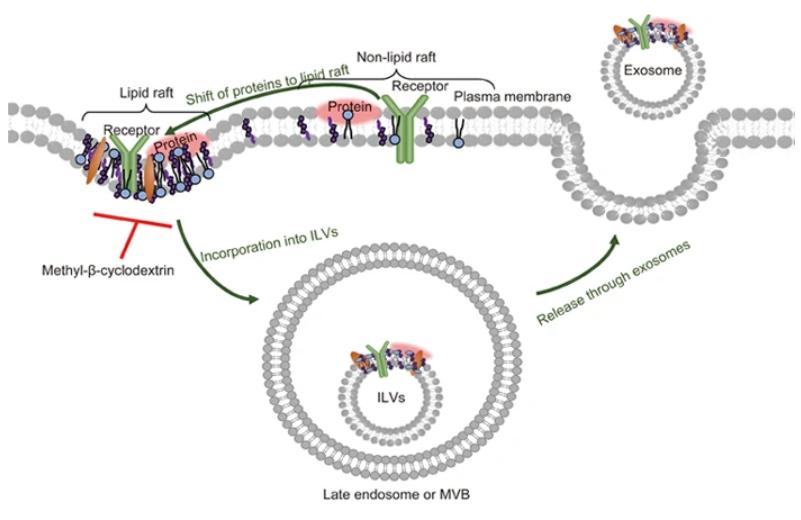Exosomal Cargo and Loading Mechanism
Online InquiryDue to the unique function of exosomes as intercellular messengers, therapeutic potential in disease diagnosis, and targeted drug delivery, knowledge regarding the content and the loading mechanisms of exosomes is of great value and requires further investigation. Creative Proteomics aims to provide high-quality exosome multi-omics services to customers in different fields. Alongside exosomal biogenesis and identification, we are committed to helping researchers and professionals understand the content and loading mechanisms of exosomes, providing insights for downstream applications.
Exosomal cargo
- Protein cargo in exosomes
As for proteomic cargo, multiple proteins are consistently identified as exosome constituents and some of them are widely used as exosome markers. Exosomes contain flotillin, Alix, Rab, GTPases, and TSG101 as they are naturally involved in membrane transport and fusion-related processes as well as the production of multivesicular bodies (MVBs). Moreover, they also encompass heat shock proteins (HSP60, HSP70, HSPA5, CCT2 and HSP90), integrins, and tetraspanins (such as CD63, CD81 and CD9), lipid-related proteins, and phospholipases.
- Nuclear acids in exosomes
In addition to proteins, exosomes also contain various nuclear acids, including DNAs, coding mRNAs, and non-coding RNAs. Non-coding RNAs include ribosomal RNA (rRNA), long noncoding RNAs (lncRNAs), micro RNAs (miRNAs), circular RNAs (circRNAs). Among them, miRNAs can be shuttled to neighboring cells via exosomes, and these specific RNA can function under certain circumstances. The mechanism of miRNA sorting to exosomes is of increasing interest to researchers.
- Lipid composition in exosomes
Lipids are the basic components of the exosome membrane and usually include cholesterol, sphingomyelin, phosphatidylserine, glycosphingolipids and ceramide. The contents of some lipids differ significantly from that of the parental cells, with sphingomyelin, ceramide, phosphatidylserine, and glycosphingolipids being 2~3-fold more abundant in exosomes than in parental cells, while phosphatidylcholine (PC) is less abundant in exosomes than in cells. In addition, exosomes are noted to have more phosphatidylserine compared to MVBs.
 Fig. 1 Lipid raft-mediated cargo loading into exosomes. (Li, Song-pei, et al., 2018)
Fig. 1 Lipid raft-mediated cargo loading into exosomes. (Li, Song-pei, et al., 2018)
Exosome loading mechanism
By transporting proteins, nucleic acids, lipids or other cellular components to cells, exosomes play an essential role in intercellular communication. Exosomal cargo may vary depending on different cellular physiological or pathological conditions. Exosomal protein cargo is mainly controlled by ESCRT-dependent and ubiquitination. The sorting of specific proteins is also regulated by RT-independent mechanisms, such as tetraspanins and lipids. Moreover, the sorting of RNA mostly depends on the RNA-binding proteins. Exosome loading mechanism is very complex and involves numerous participants and regulators. Creative Proteomics provides you with a professional exosome multi-omics analysis platform. We have high-resolution mass spectrometry instruments and a professional bioinformatics team to provide you with exosome proteomics, exosome metabolomics and exosome lipidomics analysis services. Content loading of exosomes is regulated by specialized mechanisms to ensure a very specific composition and diverse cargos own different sorting mechanisms. Our services can greatly help the study of exosomal cargo and loading mechanism, facilitating the diagnostic and therapeutic applications of exosomes.
Learn more about how we are advancing basic exosome research through our portfolio of exosome multi-omics services.
References
- Chen, Yiwen, et al. "Mechanism of cargo sorting into small extracellular vesicles." Bioengineered 12.1 (2021): 8186-8201.
- Li, Song-pei, et al. "Exosomal cargo-loading and synthetic exosome-mimics as potential therapeutic tools." Acta Pharmacologica Sinica 39.4 (2018): 542-551.
* For Research Use Only. Not for use in diagnostic procedures.



